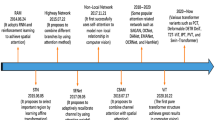Abstract
In general, the less probable an event, the more attention we pay to it. Likewise, considering visual perception, it is interesting to regard important image features as those that most depart from randomness. This statistical approach has recently led to the development of adaptive and parameterless algorithms for image analysis. However, they require computer-intensive statistical measurements. Digital retinas, with their massively parallel and collective computing capababilities, seem adapted to such computational tasks. These principles and opportunities are investigated here through a case study: extracting meaningful segments from an image.
Preview
Unable to display preview. Download preview PDF.
Similar content being viewed by others
References
Bernard, T.M., Nguyen, P.E.: Vision through the power supply of the NCP retina. In: SPIE, Charge Coupled Devices and Solid State Sensors V, vol. 2415, pp. 159–163 (1995)
Cao, F., Musé, P., Sur, F.: Extracting Meaningful Curves from Images. Journal of Mathematical Imaging and Vision 22(2), 159–181 (2005)
Desolneux, A., Moisan, L., Morel, J.-M.: Meaningful Alignments. International Journal of Computer Vision 40(1), 7–23 (2000)
Desolneux, A., Moisan, L., Morel, J.-M.: Edge detection by helmholtz principle. Journal of Mathematical Imaging and Vision 14(3), 271–284 (2001)
Desolneux, A., Moisan, L., Morel, J.-M.: A grouping principle and four applications. IEEE Transactions on Pattern Analysis and Machine Intelligence 25(4), 508–513 (2003)
Desolneux, A., Moisan, L., Morel, J.-M.: Maximal meaningful events and applications to image analysis. Annals of Statistics 31(6), 1822–1851 (2003)
Ducourthial, B., Mérigot, A.: Parallel asynchronous computation for image analysis. Proceedings of the IEEE 90(7), 1218–1229 (2002)
Gies, V., Bernard, T.M., Mérigot, A.: Convergent micro-pipelines: a versatile operator for mixed asynchronous-synchronous computations. In: IEEE International Symposium on Circuits and Systems, pp. 5242–5245 (2005)
Gies, V., Bernard, T.M., Mérigot, A.: Asynchronous regional computation capabilities for digital retinas. In: IEEE Workshop on Computer Architecture for Machine Perception and Sensing (submitted, 2006)
Komuro, T., Kagami, S., Ishikawa, M.: A dynamically reconfigurable SIMD processor for a vision chip. IEEE Journal of Solid State Circuits 39(1), 265–268 (2004)
Moini, A.: Vision Chips. Kluwer Academic Publishers, Dordrecht (2000)
Ni, Y., Devos, F., Boujrad, M., Guan, J.H.: Histogram-equalization-based adaptive image sensor for real-time vision. IEEE Journal of Solid State Circuits 32(7), 1027–1036 (1997)
Paillet, F., Mercier, D., Bernard, T.M.: Second generation programmable artificial retina. In: IEEE ASIC/SOC Conference, pp. 304–309 (1999)
Taylor, M.B., et al.: Evaluation of the raw microprocessor: An exposed-wire-delay architecture for ILP and streams. In: International Symposium on Computer Architecture, pp. 2–13 (2004)
Author information
Authors and Affiliations
Editor information
Editors and Affiliations
Rights and permissions
Copyright information
© 2006 Springer-Verlag Berlin Heidelberg
About this paper
Cite this paper
Burrus, N., Bernard, T.M. (2006). Adaptive Vision Leveraging Digital Retinas: Extracting Meaningful Segments. In: Blanc-Talon, J., Philips, W., Popescu, D., Scheunders, P. (eds) Advanced Concepts for Intelligent Vision Systems. ACIVS 2006. Lecture Notes in Computer Science, vol 4179. Springer, Berlin, Heidelberg. https://doi.org/10.1007/11864349_20
Download citation
DOI: https://doi.org/10.1007/11864349_20
Publisher Name: Springer, Berlin, Heidelberg
Print ISBN: 978-3-540-44630-9
Online ISBN: 978-3-540-44632-3
eBook Packages: Computer ScienceComputer Science (R0)




